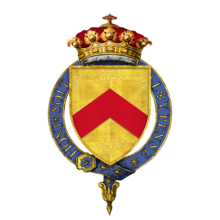Duke of Buckingham
Duke of Buckingham, referring to Buckingham, is an extinct title that has been created several times in the peerages of England, Great Britain, and the United Kingdom. There were creations of double dukedoms of Buckingham and Normanby and of Buckingham and Chandos. The last holder of the dukedom died in 1889.
There have also been Earls of Buckingham and Marquesses of Buckingham.
History
Dukes of Buckingham, first creation (1444)

The first creation of the dukedom was on 14 September 1444, when Humphrey Stafford, was made Duke of Buckingham.
On his father's side, Stafford was descended from
The 1st Duke of Buckingham was succeeded by his grandson, Henry Stafford, 2nd Duke of Buckingham, who aided Richard III in his claiming the throne in 1483, but who then led a revolt against Richard and was executed later that same year. His titles were forfeited along with the dukedom.
His son,
Dukes of Buckingham, second creation (1623)

The second creation of the dukedom was in 1623 for
His son,
Several other members of the Villiers family have been elevated to the peerage. Christopher Villiers, 1st Earl of Anglesey, and John Villiers, 1st Viscount Purbeck, were brothers of the first Duke of Buckingham. Also, Edward Villiers, 1st Earl of Jersey, was the great-nephew of the first Duke of Buckingham while Thomas Villiers, 1st Earl of Clarendon, was the second son of the second Earl of Jersey.
Dukes of Buckingham, third creation (1703)

The third creation of the dukedom, as Duke of Buckingham and Normanby, was in 1703 for
On the death of the
The seat of the family was Buckingham House, until it was bought by King George III in 1761.
Dukes of Buckingham, fourth creation (1822)
The fourth creation of the dukedom, as Duke of Buckingham and Chandos in the
He was the son of George Nugent Temple Grenville, 3rd Earl Temple, who was the son of Prime Minister George Grenville, and who had been created Marquess of Buckingham in the peerage of Great Britain in 1784. The 1st Marquess of Buckingham had married Lady Mary Nugent, daughter of Robert Nugent, 1st Earl Nugent. Mary was in 1800 created Baroness Nugent in her own right in the Peerage of Ireland, with remainder to her second son George (see the Baron Nugent). In 1788 Lord Buckingham also succeeded his father-in-law as second Earl Nugent according to a special remainder in the letters patent, and at the same time assumed by Royal licence the additional surname of Nugent.
After the 1st Marquess of Buckingham's death in 1813, his titles passed to his son
After the 2nd Duke of Buckingham and Chandos' death in 1861, the titles passed to his son, the third Duke. He was also a prominent politician and served as Lord President of the Council and as Secretary of State for the Colonies. In 1868 the Duke established his right to the Scottish lordship of Kinloss before the Committee for Privileges of the House of Lords. On his death in 1889 without male issue, the dukedom and its subsidiary titles (the marquessate of Buckingham, marquessate of Chandos, earldom of Temple and earldom of Nugent) became extinct. The lordship of Kinloss passed to his daughter Mary. The earldom of Temple of Stowe passed to his sister's son William Temple-Gore-Langton because the title had been created with a special remainder to her heirs male. The viscountcy of Cobham, which had also been created with a special remainder, passed to Charles Lyttelton, 5th Baron Lyttelton, a descendant of Hester Grenville, 1st Countess Temple's sister Christian, who had married Sir Thomas Lyttelton, 4th Baronet.
List of title holders
Dukes of Buckingham (1444)
- Humphrey Stafford, 1st Duke of Buckingham (1402–1460), created Duke of Buckingham in 1444
- Humphrey Stafford, Earl of Stafford (1425–1458), eldest son of the 1st Duke, predeceased his father
- Henry Stafford, 2nd Duke of Buckingham (1455–1483), only son of Lord Stafford, was attainted for treason in 1483
- Edward Stafford, 3rd Duke of Buckingham (1477–1521), eldest son of the 2nd Duke, was restored to his father's honours in 1485, but then executed for treason in 1521 and posthumously attainted in 1523
Dukes of Buckingham (1623)
- George Villiers, 1st Duke of Buckingham (1592–1628), created Duke of Buckingham and Earl of Coventry in 1623
- George Villiers, 2nd Duke of Buckingham (1628–1687), younger son of the 1st Duke
Dukes of Buckingham and Normanby (1703)
- John Sheffield, 1st Duke of Buckingham and Normanby (1648–1721), created Duke of Buckingham and Normanby in 1703
- John Sheffield, Marquess of Normanby (1710)
- Robert Sheffield, Marquess of Normanby (1711–1714)
- Edmund Sheffield, 2nd Duke of Buckingham and Normanby (1716–1735)
Dukes of Buckingham and Chandos (1822)
- Richard Temple-Nugent-Brydges-Chandos-Grenville, 1st Duke of Buckingham and Chandos (1776–1839), created Duke of Buckingham and Chandos in 1822
- Richard Temple-Nugent-Brydges-Chandos-Grenville, 2nd Duke of Buckingham and Chandos (1797–1861)
- Richard Temple-Nugent-Brydges-Chandos-Grenville, 3rd Duke of Buckingham and Chandos (1823–1889)
- George Temple-Nugent-Brydges-Chandos-Greenville-Buckingham, 3rd Duke of Buckingham and Chandos, LordShip of Buckingham and Chandos (1857–1902)
